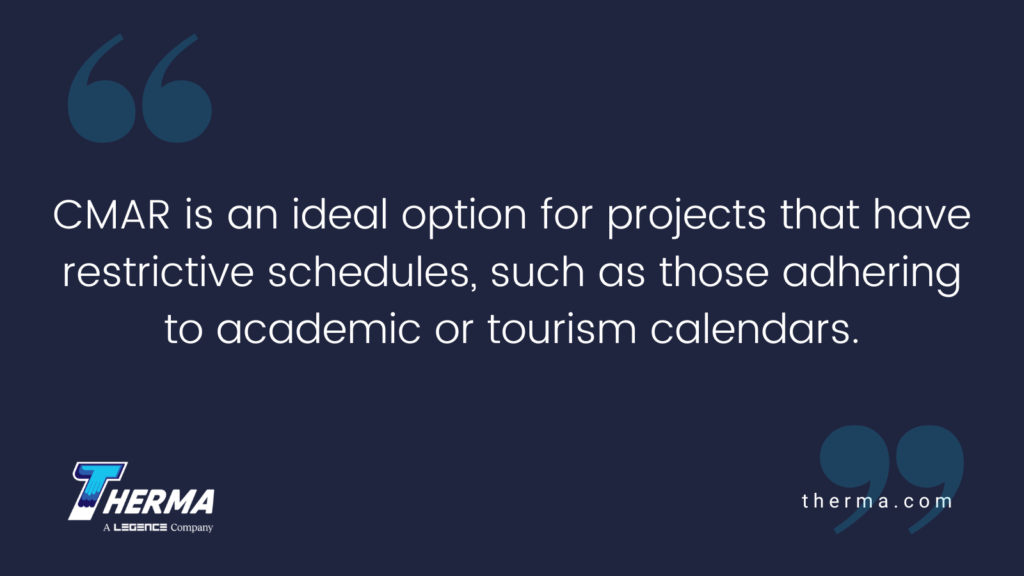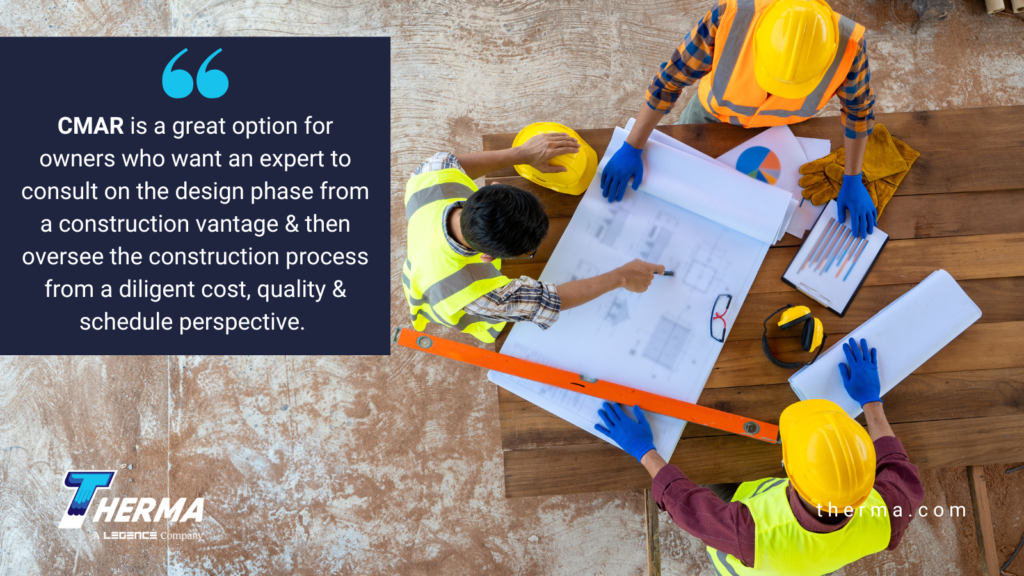by Ali Kriscenski
There are several types of construction management processes, and selecting the right one depends on your specific project requirements. This article will take a close look at the Construction Manager at Risk (CMAR) method and the types of projects for which it is most effective.
Choosing the Right Project Delivery Method
Making a capital investment can be a daunting undertaking with significant costs and responsibility. Depending on your organization’s structure, there could be a large number of stakeholders, each with a vested interest in the project’s outcome regarding budget, schedule, or other success metrics. As today’s construction projects become increasingly complex in scope, standards and regulations, choosing the most effective project delivery method is critical.
Owners looking to initiate a construction project can assess CMAR against other methods such as design-build, where one firm is entrusted with the design and construction management process. This method is useful for highly specialized projects under a large portion of a project’s scope, such as a mechanical design-build initiative.
Another option is for the owner to act as construction manager and hold contracts with each trade, including the general contractor (GC) who manages schedule, procurement and quality control. This option can be good for owners who possess extensive in-house construction management experience but the option may require considerable personnel resources.
When To Choose the CMAR Option
CMAR is a great option for owners who want an expert to consult on the design phase from a construction vantage and then oversee the construction process from a diligent cost, quality and schedule perspective. An experienced CMAR firm can help with architect or engineer selection if desired, but can also work with established design teams on a project. Either way, engaging a CMAR firm early in the planning process can be beneficial to resolving design conflicts, and offers valuable engineering options based on their expertise with local building codes and regulations.
How the CMAR Process Works
Owners can select a CMAR firm early in the project planning in advance of estimating and trade bid reviews. Finding a firm that has relevant project experience and established working relationships with specialized trade contractors is key. The CMAR will be responsible for thoroughly reviewing all construction documents — including drawings and specifications — and ensuring all scopes of work and materials are included in the project estimating process.
The next step for the Construction Manager (CM) is to establish the construction budget as a guaranteed maximum price (GMP). The GMP becomes part of the CMAR contract along with the project documentation. The GMP can include general contingency for elevated costs that don’t qualify as change orders. Owners can require approval of contingency cost spending, ensuring thorough accounting. In the project planning phase, the CM can work closely with the design team to ensure the GMP and design intent are fully aligned.
One of the key benefits of the CMAR process is the opportunity to engage the expertise of the CM firm in the pre-construction phase. This stage allows the construction and design teams to create a collaborative project environment before entering the construction phase. Throughout planning, the CM can revise estimates against design or specification adjustments. Additionally, the CM will have an overview on design changes and be able to clarify the adjustments with trades in the field.
Advantages of CMAR Method
With a CMAR contract, the construction manager is involved early in the project development. This typically creates a high level of collaboration that carries through the project duration. The opportunity to work through design revisions, and also to engage trades on site coordination, alleviates potential construction conflicts.
This method also prioritizes schedule and budget control, as the CM is working off of the GMP against specific project milestones. As any change that arises in the construction phase requires either a change order or contingency approval, the CMAR method can be particularly beneficial to budget adherence.
CMAR is an ideal option for projects that have restrictive schedules, such as those adhering to academic or tourism calendars. It is also a good choice for complex projects that may have unforeseen challenges related to demolition, abatement, site or soil conditions. Lastly, projects that have large design and construction teams including consultants, architects, designers, engineers and specialized trades can benefit from the collaborative CMAR process.
When To Avoid CMAR
Not all projects require the level of collaboration and oversight that CMAR provides. Projects that are simple in scope or fairly straightforward in design may be more suited to another project delivery method. With CMAR-run projects, the focus on delivering design intent within schedule and budget doesn’t lean towards the lowest bidder. Publicly funded projects that are price-driven are not conducive to a CMAR process.
At Therma, our team operates within a collaborative outlook and has extensive experience working with designers, owners and construction teams throughout all phases of construction. Our team members can provide the expertise needed to resolve design conflicts early in the planning process to ensure smooth project execution. Contact Therma today to learn more about our preconstruction services.
Ali Kriscenski was trained in high-performance building design at Boston Architectural College. She has worked with leading architecture and construction firms in NYC and New England and served on the executive team at the Forest Stewardship Council International. She was the managing editor at Inhabitat and has worked pro bono for the Green Building Institute, ISEAL Alliance and Habitat for Humanity.
Sources
BUILD – Improving Project Efficiency with Pre-construction Planning
Project Management Institute – Selecting the Best Project Delivery System









